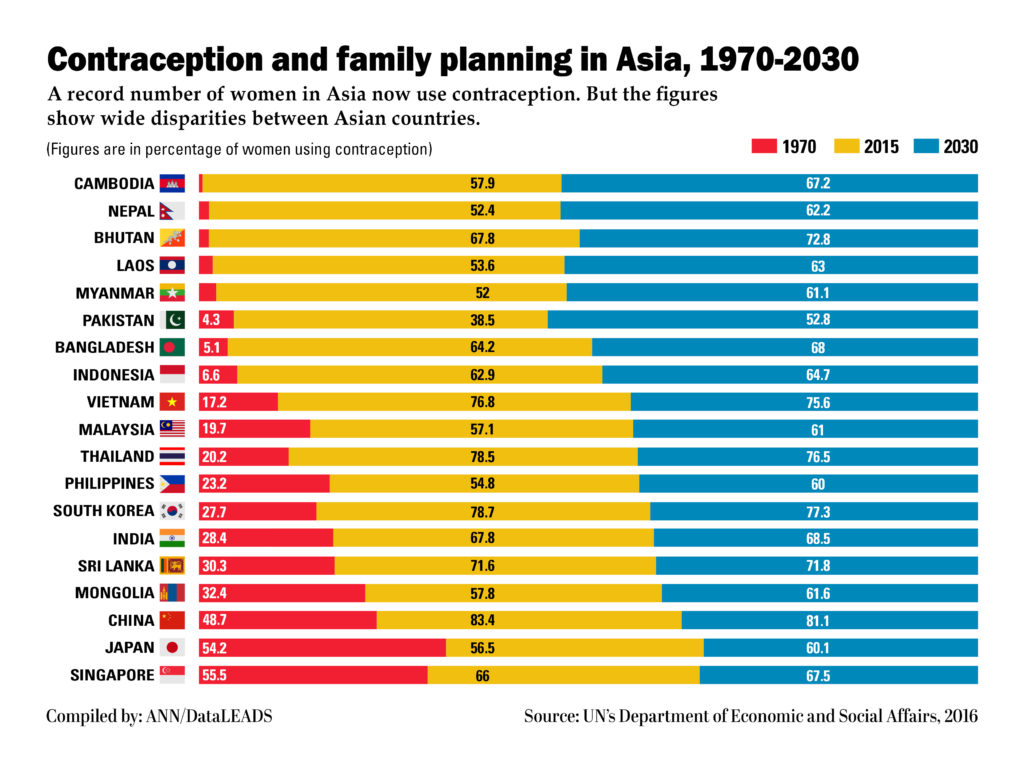Contraception and family planning in Asia, 1970-2030

In Asia, a wide number of women now use contraception, the trend which is seen as contributing towards containing the ever expanding world population. Within the region, the highest levels of contraceptive use are found mainly in the Eastern and South Eastern regions, with an estimated high of 83.4 per cent in China. In all, countries in Asia have contraceptive prevalence levels of 50 per cent or more. The lowest level of contraceptive prevalence in Asia was in Pakistan at 38.5 per cent in 2015.
Worldwide 64 per cent of ‘married and cohabiting women used modern or traditional methods of contraception in 2015 – a significant rise from 36 per cent in 1970’, according to the UN’s Department of Economic and Social Affairs data. The number of women using contraceptive is expected to increase all across Asia except China and South Korea where the rate is expected to drop by almost 2 per cent and 1 per cent respectively by 2030.
However data shows a stark disparity in the range of percentage of women taking recourse to contraceptive methods in Asia. Cambodia had the lowest prevalence rate in Asia in the 1970 but has seen a significant increase in the use of contraceptives in last four decades. In 1970 the percentage of women using contraceptives was 0.6 which saw an increase to 57.9 in 2015. It is expected to reach 67.2 per cent by year 2030.
A meagre 1.8 per cent of women were using contraceptives in 1970 in Nepal which saw an increase to 52.4 per cent in 2015. Only 1. 8 per cent of Bhutanese women used contraceptives which increased to 67.8 per cent in 2015. It is estimated to reach 72.8 per cent by 2030.
In Laos, 53.6 per cent of women were estimated to be using contraceptive methods in 2015 which is projected to go up to 63 per cent by next decade. Myanmar which has a wide disparity between rural and urban population in the choice of contraceptive methods went from 2.6 per cent in 1970 to 52 per cent in 2015 and is expected to reach 61.1 per cent by 2030.
Although Pakistan has seen resistance on birth control policies, the country has updated its commitment to implement family planning methods. The percentage of women who will use contraceptives by 2030 is estimated to be 52.8. Bangladesh has also seen an increase in the use of family planning methods and is expected to reach 68 per cent by 2030.
Singapore has been far ahead of other Asian countries in 1970 with 55.5 per cent women using contraceptives in 1970. It saw an increase to 66 per cent in 2015 and is expected to rise to 67.5 per cent by 2030. Japan was at 54.2 per cent in 1970 and saw an increase to 56.5 per cent in 2015. it is expected to go up to 60.1 per cent by 2030.
India, the first country in the world to launch a national programme for family planning has seen a surge in number of women using contraceptives to 67.8 per cent in 2015. It is estimated to rise by 1 per cent by 2030. In the South Asian region, Sri Lanka has been ahead of its neighbours at 30.3 per cent in the 1970 to an increase of 71.6 per cent in 2015.
Indonesia has jumped from 6.6 to 62.9 per cent in 2015. Vietnam and Malaysia have seen a rise to 76.8 per cent and 56.1 per cent respectively. Thailand, Philippines and Malaysia are expected to see a rise by 61, 76 and 60 per cent respectively by 2030.
At 78.7 per cent in 2015, South Korea has been ahead of other Asian countries and is expected to drop to 77.3 per cent by 2030. However China, despite 2 per cent drop by 2030, will still have the highest levels of contraceptive use.
According to the UN the region can save billions of dollars if family planning is implemented properly as it would bring down unintended pregnancies and avert unsafe abortions. Contraception use also prevents new infections in women, men and adolescents and reduces maternal mortality
